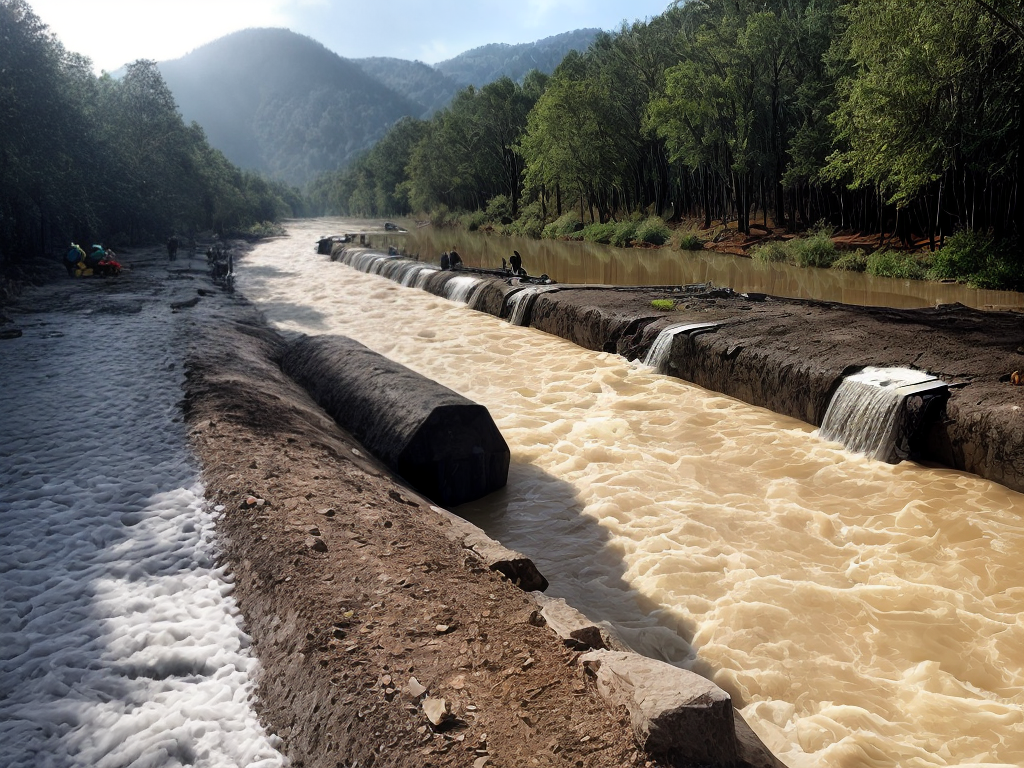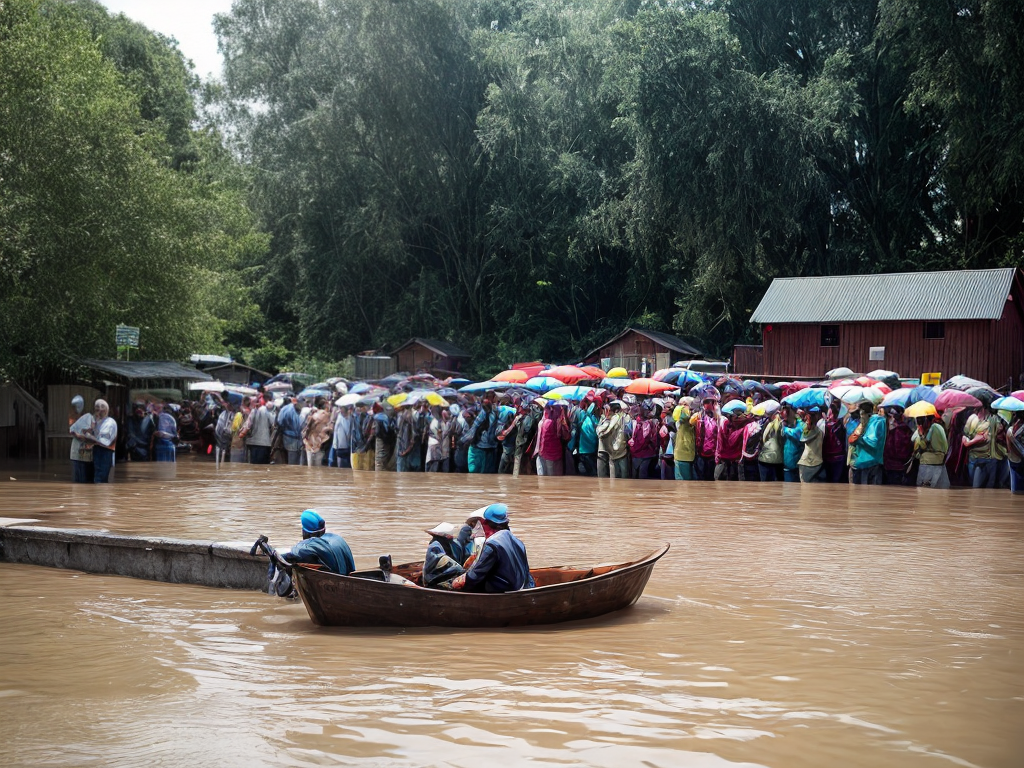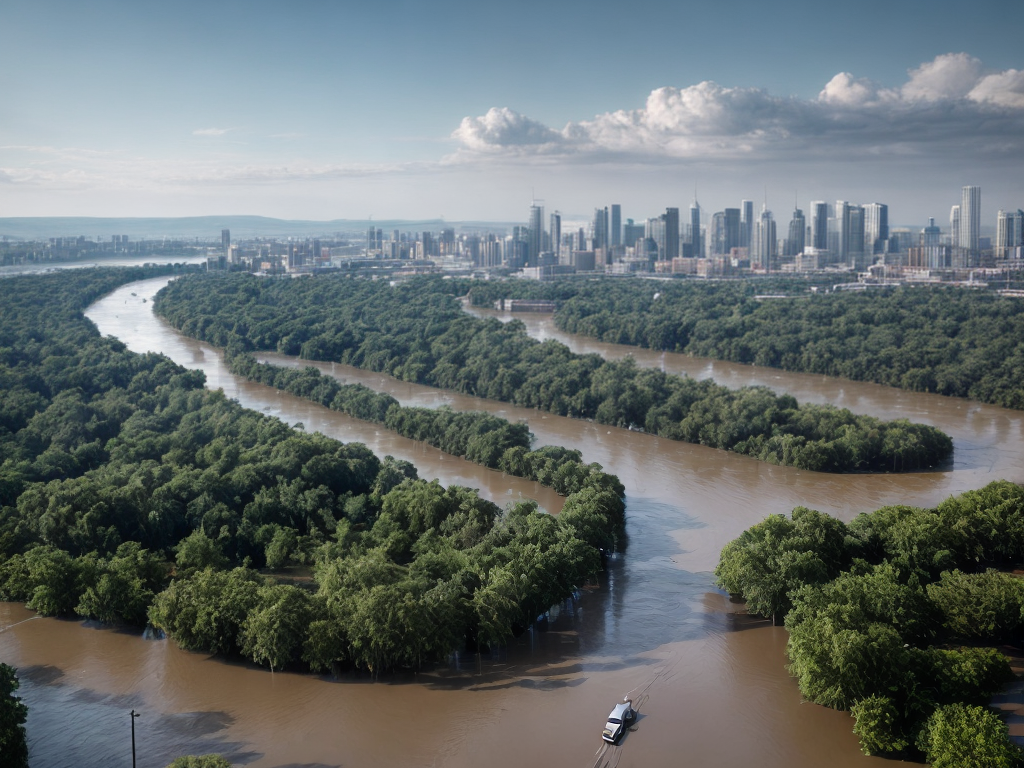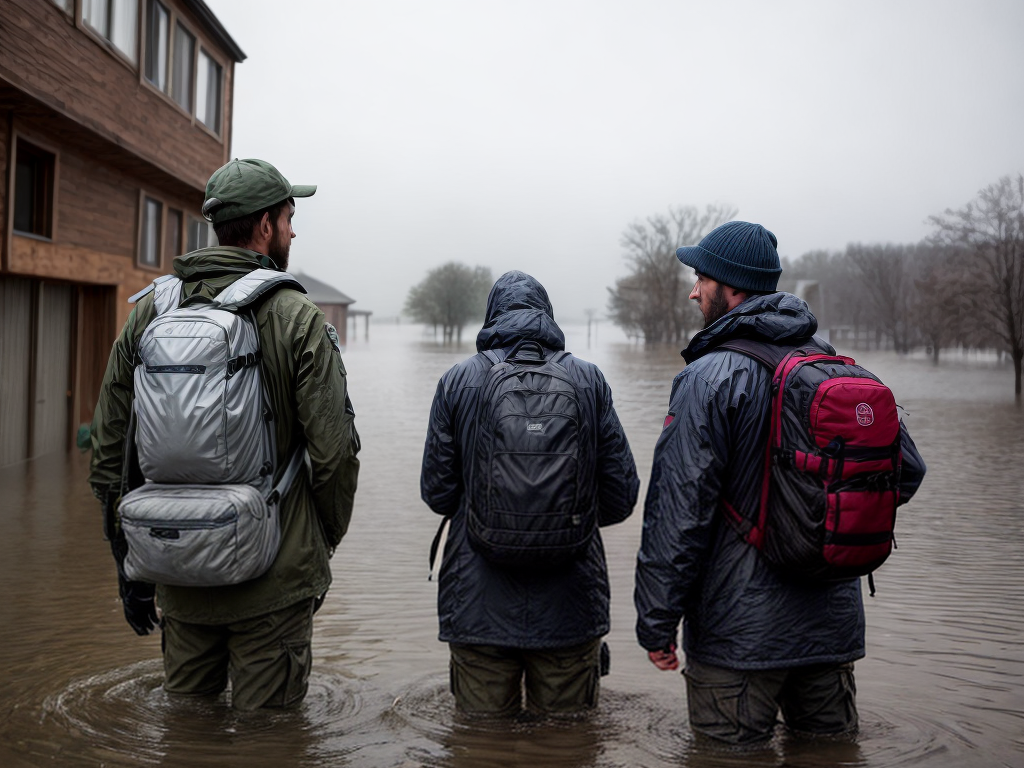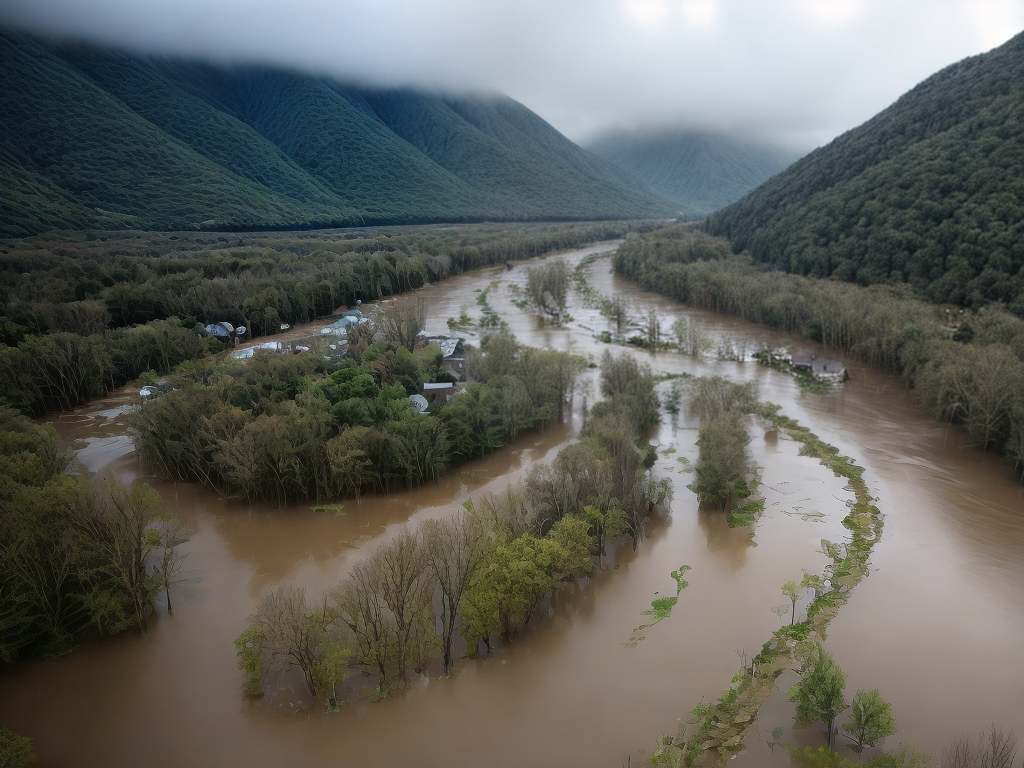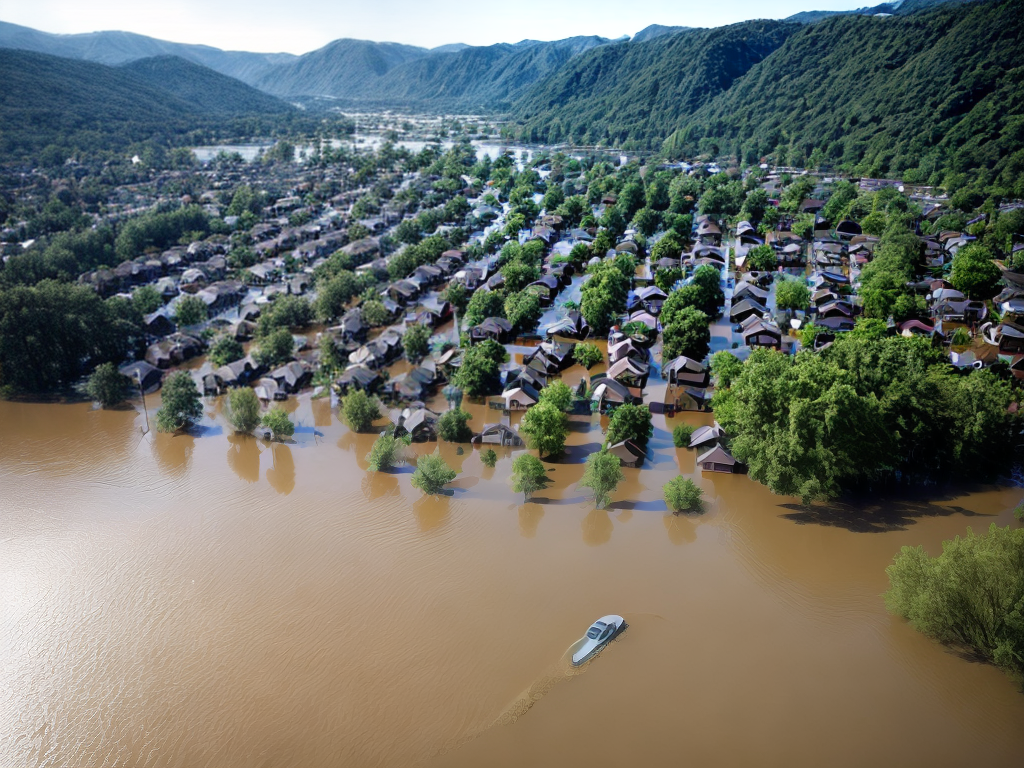When it comes to addressing the challenges posed by flooding in urban areas, there are certain practices that urban planners can employ to ensure the safety and resilience of communities. We begin by acknowledging the importance of flood risk assessment, a crucial step in understanding and mitigating the potential impacts of flooding. By carefully examining flood hazard zones and analyzing historical data, planners can gain valuable insights into the vulnerabilities of their cities. But it doesn’t stop there; the use of Geographic Information Systems (GIS) and the assessment of vulnerable infrastructure play essential roles in developing effective strategies. And that’s just the beginning.
Key Takeaways
- Community involvement is crucial in flood risk assessment, as it fosters a sense of ownership and responsibility among residents, leading to a more resilient and prepared community.
- Understanding flood hazard zones and conducting vulnerability assessments are essential for identifying high-risk areas, informing land use planning, and minimizing social and economic impacts of flooding.
- Collecting and analyzing historical data, including local knowledge and experiences, enhances the accuracy of flood risk assessments and helps anticipate future flood risks.
- Utilizing Geographic Information Systems (GIS) allows for spatial analysis of flood risk data, identifying vulnerable infrastructure, improving decision-making in land use planning, and facilitating communication and collaboration among stakeholders.
Importance of Flood Risk Assessment
Flood risk assessment is crucial for urban planners as it helps us understand and mitigate the potential impacts of flooding on our communities. By actively engaging with the community and involving them in the assessment process, we can reap numerous benefits. Firstly, community involvement fosters a sense of ownership and responsibility among residents. When individuals are actively engaged in understanding and addressing flood risks, they become more invested in the solutions and are more likely to take necessary actions to protect their homes and businesses. This increased sense of community ownership ultimately leads to a more resilient and prepared community.
Another benefit of community involvement in flood risk assessment is the economic implications that it brings. Engaging community members allows for the sharing of local knowledge and experiences. This firsthand information can provide valuable insights into flood-prone areas, historical flooding patterns, and vulnerable infrastructure. By incorporating this local knowledge into our assessments, we can develop more accurate flood risk models and make informed decisions about land use planning and infrastructure development. This, in turn, has the potential to save significant financial resources by ensuring that investments are made in the most appropriate and flood-resistant areas.
Innovative strategies such as crowdsourcing, citizen science initiatives, and participatory mapping can be employed to actively involve community members in flood risk assessment. These approaches not only enhance the quality and accuracy of our assessments but also empower residents to contribute to the long-term resilience of their communities. By valuing their input and insights, we can create a more inclusive and effective flood risk management framework. Ultimately, community involvement in flood risk assessment is a win-win situation, benefiting both the individuals living in flood-prone areas and the city as a whole.
Understanding Flood Hazard Zones
Let’s begin by discussing the two key points that are crucial in understanding flood hazard zones: flood risk mapping and vulnerability assessment. Flood risk mapping helps us identify areas that are at a higher risk of flooding, allowing urban planners to make informed decisions when it comes to development and infrastructure. Vulnerability assessment, on the other hand, helps us understand the potential impacts of flooding on communities and individuals, enabling us to implement appropriate measures to reduce risks and enhance resilience. By focusing on these points, we can effectively assess flood hazard zones and develop strategies to mitigate their impact.
Flood Risk Mapping
To effectively assess flood risk in urban planning, it is crucial to understand flood hazard zones through the process of flood risk mapping. By creating accurate and up-to-date flood risk maps, urban planners can make informed decisions and develop innovative strategies to mitigate the impact of floods. Here are three key reasons why flood risk mapping is essential:
- Identifying high-risk areas: Flood risk maps help identify areas that are most vulnerable to flooding, allowing planners to prioritize resources and implement targeted interventions.
- Informing land use planning: Flood risk maps provide valuable information for land use planning, ensuring that development is appropriately located and designed to withstand potential flood events.
- Facilitating flood risk communication: Flood risk maps serve as a communication tool, enabling planners to effectively convey the potential risks to stakeholders, policymakers, and the public, fostering a shared understanding and promoting proactive flood risk management.
Vulnerability Assessment
After understanding flood hazard zones through flood risk mapping, the next step is to assess vulnerability in order to gain a comprehensive understanding of the potential impact of floods on urban areas. Vulnerability assessment techniques play a crucial role in this process, as they help identify the weaknesses and strengths of the community in relation to flooding. By analyzing factors such as infrastructure, land use patterns, population density, and socio-economic conditions, planners can determine the areas most at risk and develop appropriate mitigation strategies. This assessment is essential to minimize the social and economic impacts of flooding. By understanding the vulnerabilities of urban areas, innovative solutions can be implemented, such as the construction of flood-resistant buildings or the creation of green spaces to absorb excess water. Through effective vulnerability assessment, urban planners can make informed decisions to create resilient and sustainable cities.
Collecting and Analyzing Historical Data
Let’s talk about the points of data collection methods and analyzing data trends when it comes to collecting and analyzing historical data for flood risk assessment. By understanding different data collection methods, we can gather accurate and reliable information about past flood events. Analyzing data trends allows us to identify patterns and make informed predictions about future flood risks.
Data Collection Methods
Historical data for flood risk assessment can be collected and analyzed using various methods. To ensure accuracy and reliability, data validation techniques should be employed. This involves cross-checking and verifying the collected data to eliminate errors and inconsistencies. One way to collect historical data is through remote sensing, which utilizes satellite imagery and aerial photographs. This method provides a comprehensive view of the area, enabling planners to identify flood-prone zones and analyze patterns over time. Another method is through the use of historical records, such as rainfall and river level data. These records are valuable in understanding past flood events and can help in predicting future risks. Lastly, community engagement and citizen science initiatives can provide valuable data, enhancing the accuracy and inclusivity of flood risk assessments.
Analyzing Data Trends
To analyze data trends in flood risk assessment, we employ various methods to collect and analyze historical data. One crucial aspect is analyzing rainfall patterns, as they play a significant role in predicting flood events. By examining historical rainfall data, we can identify patterns and trends that help us anticipate future flood risks. To make this process more engaging, we can use a table to showcase the findings.
| Year | Rainfall (mm) |
|---|---|
| 2018 | 500 |
| 2019 | 700 |
| 2020 | 600 |
| 2021 | 550 |
From the table, we can observe that rainfall levels have been consistently high, with a slight decrease in 2021. This information suggests a potential flood risk in the area. By analyzing such data trends, urban planners can make informed decisions and implement innovative strategies to mitigate flood risks effectively.
Utilizing Geographic Information Systems (GIS)
How can urban planners effectively utilize Geographic Information Systems (GIS) for flood risk assessment? GIS applications provide urban planners with powerful tools for analyzing and visualizing data related to flood risk. By harnessing the capabilities of GIS, planners can make more informed decisions and develop innovative strategies to mitigate flood hazards in urban areas.
Here are three ways urban planners can leverage GIS for flood risk assessment:
- Data integration and analysis: GIS allows planners to integrate various datasets, such as elevation, land use, and hydrological information, into a single platform. This enables them to analyze the data spatially and identify areas at higher risk of flooding. By overlaying different layers of information, planners can gain valuable insights into flood-prone areas and prioritize intervention measures accordingly.
- Visualization and communication: GIS provides powerful data visualization capabilities, allowing planners to create interactive maps, charts, and 3D models. These visual representations help communicate complex flood risk information to stakeholders and the general public in a more accessible and engaging way. By effectively visualizing flood risks, planners can raise awareness, promote understanding, and facilitate collaborative decision-making processes.
- Scenario planning and risk assessment: Using GIS, planners can simulate different flood scenarios and assess their potential impacts on urban areas. By modeling various factors, such as rainfall intensity and river flow rates, planners can evaluate the effectiveness of different flood management strategies and identify the most suitable options. This allows for the development of adaptive and resilient urban plans that can withstand future flood events.
Assessing Vulnerable Infrastructure
As urban planners, we need to understand the critical infrastructure vulnerabilities in our cities to effectively assess flood risks. By using risk assessment techniques, we can identify the areas and systems that are most susceptible to flooding, such as transportation networks, power plants, and water treatment facilities. Armed with this knowledge, we can then develop mitigation strategies to protect and strengthen our vulnerable infrastructure, ensuring the safety and resilience of our cities in the face of flooding events.
Critical Infrastructure Vulnerabilities
We must assess the vulnerabilities of critical infrastructure to ensure that urban planners are equipped to address flood risks effectively. By understanding the weaknesses in our critical infrastructure, we can develop innovative strategies to protect and strengthen it against potential flood events. Here are three risk assessment techniques that can help us identify critical infrastructure vulnerabilities:
- Asset mapping: Creating a comprehensive inventory of critical infrastructure, including transportation systems, power grids, and water supply networks, allows us to identify areas that are most at risk during flooding.
- Vulnerability analysis: Assessing the susceptibility of critical infrastructure to flood damage helps us prioritize mitigation efforts and allocate resources effectively.
- Scenario planning: By simulating different flood scenarios and their potential impacts on critical infrastructure, we can develop proactive strategies to minimize damage and ensure continuity of essential services.
Risk Assessment Techniques
To accurately assess the vulnerabilities of critical infrastructure, we employ various risk assessment techniques. These techniques allow us to identify potential flood risks and develop effective mitigation strategies. One approach is the use of advanced modeling techniques, which enable us to simulate various flood scenarios and evaluate their potential impact on infrastructure. By analyzing data such as rainfall patterns, topography, and the condition of existing infrastructure, we can assess the vulnerability of critical assets and prioritize necessary interventions. Additionally, we utilize risk mapping, which involves the visualization of flood-prone areas and the identification of key infrastructure within these zones. This information helps urban planners make informed decisions and implement measures to enhance resilience. Through the integration of risk assessment techniques and advanced modeling approaches, we can create innovative solutions to address flood risks in urban areas.
| Risk Assessment Techniques | Advanced Modeling Approaches |
|---|---|
| Risk mapping | Hydraulic modeling |
| Vulnerability assessments | Data-driven simulations |
| Impact analysis | Scenario-based modeling |
Mitigation Strategies
One effective approach for assessing vulnerable infrastructure and developing mitigation strategies is through the analysis of flood risk. By understanding the potential impact of floods on infrastructure, urban planners can implement targeted measures to reduce vulnerability and enhance resilience. Here are three key mitigation strategies that can be employed:
- Elevating Infrastructure: Raising critical infrastructure such as roads, bridges, and electrical systems can minimize the risk of damage during flood events. This approach ensures that essential services remain operational, even in the face of rising waters.
- Implementing Green Infrastructure: Integrating nature-based solutions, such as green roofs, rain gardens, and permeable pavements, can help absorb and slow down stormwater runoff. These sustainable flood control techniques not only mitigate flood risk but also improve the overall urban environment.
- Building Flood Barriers: Constructing flood barriers, such as levees, flood walls, and embankments, can protect vulnerable areas from inundation. These physical barriers serve as a line of defense against floodwaters, safeguarding critical infrastructure and reducing potential damage.
Evaluating Climate Change Projections
In assessing flood risk for urban planners, it is crucial to effectively evaluate climate change projections. As urban planners, we understand the importance of accurate data and predicting future trends to make informed decisions. Evaluating data accuracy is the first step in assessing climate change projections. It is essential to ensure that the data we rely on is reliable, up-to-date, and based on robust scientific methodologies. By utilizing advanced technologies and innovative methods, we can enhance the accuracy of our data evaluation process.
Predicting future trends is another critical aspect of evaluating climate change projections. As urban planners, we need to be forward-thinking and proactive in our approach. We must look beyond the present and consider the long-term implications of climate change on flood risk. By analyzing historical data, studying climate models, and collaborating with climate scientists, we can gain valuable insights into potential future scenarios.
To effectively evaluate climate change projections, we should embrace innovation and explore cutting-edge technologies. Machine learning algorithms, artificial intelligence, and big data analytics can help us analyze vast amounts of climate data, identify patterns and trends, and make more accurate predictions. Additionally, engaging with interdisciplinary teams and leveraging diverse expertise can bring fresh perspectives and innovative solutions to the table.
Incorporating Land Use Planning
Now let’s talk about incorporating land use planning into flood risk assessment. One important aspect is the implementation of zoning regulations that take into account flood risk zones. By properly designating areas prone to flooding as restricted for certain types of development, urban planners can help mitigate the potential damage caused by floods. Another key consideration is the integration of green infrastructure, such as permeable pavements and bioswales, which can help absorb and manage stormwater runoff, reducing the risk of flooding in urban areas.
Zoning Regulations and Flood Risk
As urban planners, we actively incorporate land use planning into zoning regulations to effectively address flood risk. By integrating zoning regulations and flood risk considerations into our urban development plans, we can create resilient and sustainable communities. Here are three innovative ways in which we can achieve this:
- Implementing setback requirements: Setting minimum distance requirements between buildings and flood-prone areas can minimize the risk of damage during flooding events.
- Promoting green infrastructure: Incorporating green spaces, such as parks and permeable surfaces, can help absorb excess water and reduce flood risk.
- Encouraging mixed land use: By strategically combining residential, commercial, and recreational areas, we can reduce the need for extensive transportation networks, minimizing impervious surfaces and decreasing flood risk.
Integrating Green Infrastructure
By incorporating green infrastructure into our land use planning, we can effectively mitigate flood risk and create more resilient communities. Green infrastructure refers to the strategic use of natural elements, such as urban green spaces, to manage stormwater and reduce flooding. Not only does this approach provide flood protection, but it also offers numerous other benefits. Urban green spaces, for instance, can enhance air and water quality, reduce heat island effects, and improve overall community well-being. Integrating green infrastructure into land use planning promotes innovation by challenging traditional approaches to flood risk management. It encourages urban planners to think creatively and find sustainable solutions that blend nature with urban development. By embracing green infrastructure, we can build more resilient cities that are better equipped to face the challenges of a changing climate.
Engaging Stakeholders in the Assessment Process
Effective engagement of stakeholders plays a pivotal role in ensuring a comprehensive flood risk assessment process for urban planners. Engaging stakeholders and promoting community engagement is essential for successful flood risk assessment and management. Here are three key strategies for engaging stakeholders in the assessment process:
- Establishing collaborative partnerships: Building strong relationships with key stakeholders, such as local residents, community organizations, and government agencies, is crucial. By actively involving these stakeholders from the beginning, planners can tap into their knowledge, expertise, and concerns regarding flood risk. This collaboration fosters a sense of ownership and empowers stakeholders to actively participate in decision-making processes.
- Utilizing innovative communication methods: Traditional methods of engagement, such as public meetings and surveys, are important but may not always capture the diverse perspectives and experiences of all stakeholders. To address this, planners can leverage innovative communication tools, such as interactive online platforms, social media, and mobile applications. These technologies enable real-time information sharing, interactive mapping, and virtual town halls, creating opportunities for broader engagement and inclusivity.
- Promoting education and awareness: Engaging stakeholders requires fostering a shared understanding of flood risk and its implications. Planners can organize workshops, training sessions, and public awareness campaigns to educate stakeholders about flood risk assessment methodologies, floodplain management strategies, and the importance of their active involvement. By enhancing stakeholders’ knowledge and awareness, planners can empower them to contribute meaningfully to the assessment process and advocate for sustainable flood risk management solutions.
Conducting Hydraulic and Hydrological Modeling
To conduct hydraulic and hydrological modeling, we gather data and analyze it to understand the flow of water in urban areas. This modeling process plays a crucial role in flood risk assessment for urban planners, as it helps us understand how water behaves in different scenarios and identify areas that are prone to flooding. However, it is important to acknowledge the limitations of hydraulic modeling.
Hydraulic modeling involves simulating the behavior of water in urban areas, considering factors such as topography, infrastructure, and land use. It helps us understand how water flows through streets, drains, and other hydraulic structures. By analyzing this data, we can identify areas where water accumulates, potential bottlenecks, and areas at higher risk of flooding.
However, it is essential to recognize the limitations of hydraulic modeling. One of the key challenges is the accuracy of the input data. The quality and resolution of the topographic data, for example, can significantly impact the accuracy of the model’s predictions. Additionally, the assumptions made during the modeling process can introduce uncertainties.
To complement hydraulic modeling, hydrological modeling techniques are often employed. Hydrological modeling focuses on understanding how rainfall and other factors contribute to the overall water flow in a given area. It helps us estimate the volume of water that enters the urban system, which is crucial for flood risk assessment.
Innovative techniques, such as data-driven approaches and advanced simulation models, are emerging to overcome these limitations. These techniques involve integrating real-time data, such as weather forecasts and sensor data, to improve the accuracy of the models. Additionally, machine learning algorithms can be used to optimize the model parameters and improve the overall performance.
Estimating Potential Damage and Losses
Estimating potential damage and losses is a crucial step in flood risk assessment for urban planners. By accurately estimating the economic impact and assessing community preparedness, planners can develop effective strategies to mitigate the effects of flooding and minimize losses. Here are three key considerations when estimating potential damage and losses:
- Comprehensive data collection: Gathering accurate and up-to-date data is essential for estimating potential damage and losses. This includes information on infrastructure, property values, land use, and population density. By utilizing innovative technologies such as remote sensing and geographic information systems (GIS), planners can obtain detailed data that can help identify areas at high risk of damage.
- Quantitative modeling: Planners can use advanced modeling techniques to estimate the potential economic impact of flooding. These models take into account factors such as flood depth, duration, and velocity to assess the vulnerability of different areas. By simulating various flood scenarios, planners can determine the potential damage to infrastructure, homes, businesses, and the overall economy.
- Community resilience assessment: Assessing community preparedness is crucial for estimating potential losses. This involves evaluating the effectiveness of existing flood protection measures, early warning systems, evacuation plans, and emergency response capabilities. By identifying gaps and weaknesses in community preparedness, planners can develop strategies to enhance resilience and reduce the impact of future floods.
Innovation plays a vital role in estimating potential damage and losses. By incorporating emerging technologies such as machine learning and artificial intelligence, planners can improve the accuracy of their assessments and develop more effective flood risk management strategies. Additionally, engaging with stakeholders and utilizing community input can provide valuable insights and ensure that the estimation process considers the unique needs and challenges of the community.
Identifying Effective Flood Control Measures
Now, let’s shift our focus to identifying the most suitable flood control measures following a thorough assessment of potential damage and losses. To effectively mitigate the risks of flooding, urban planners must consider a range of flood control strategies and flood prevention measures. These measures should not only minimize the impact of flooding but also promote innovation and sustainable development.
To assist urban planners in selecting the most appropriate flood control measures, the table below outlines four key strategies along with their respective benefits and limitations:
| Flood Control Strategy | Benefits | Limitations |
|---|---|---|
| Natural Flood Control | Preserves natural habitats and ecosystems | Requires large land areas for implementation |
| Structural Measures | Provides immediate protection | Expensive to construct and maintain |
| Non-structural Measures | Promotes community engagement and education | May not provide sufficient protection against major floods |
| Integrated Approach | Combines multiple strategies for resilience | Requires coordination among various stakeholders |
Implementing Early Warning Systems
Implementing early warning systems is crucial for effectively managing and responding to flood events in urban areas. As urban planners, we must embrace innovative strategies to address the challenges of early warning system implementation. Here are three key considerations:
- Technological advancements: With the rapid progress in technology, we can leverage sensors, remote sensing, and real-time data analysis to improve the accuracy and timeliness of flood warnings. By integrating these technologies into our early warning systems, we can detect flood events earlier and provide more precise information to residents and emergency management agencies.
- Community engagement: A successful early warning system relies on the active participation of the community. Engaging residents in flood risk awareness campaigns and educating them about the benefits of early warning systems can significantly enhance their preparedness and response. Additionally, involving local stakeholders, such as businesses and community organizations, can foster collaboration and ensure a coordinated approach towards flood risk management.
- Multi-agency collaboration: Flood events require a multi-agency response. Collaborating with various agencies, such as meteorological departments, emergency management agencies, and local governments, can enhance the effectiveness of early warning systems. Sharing data, coordinating response plans, and conducting regular drills and simulations can improve the overall preparedness and response capabilities of the urban area.
The benefits of early warning systems are numerous. They enable timely evacuation, reducing the risk to human lives and property. By providing accurate and reliable information, these systems also minimize panic and confusion during flood events. Moreover, early warnings allow emergency management agencies to allocate resources effectively and efficiently, ensuring a swift response and quicker recovery.
Implementing early warning systems may present challenges, such as financial constraints, technical expertise, and community acceptance. However, by embracing innovation, engaging the community, and fostering collaboration, urban planners can overcome these challenges and create a safer and more resilient urban environment.
Developing Emergency Response Plans
To effectively respond to flood events, urban planners must develop comprehensive emergency response plans. These plans are crucial in mitigating the impact of floods and ensuring the safety of residents in affected areas. Developing evacuation plans and coordinating response efforts are key components of these emergency response plans.
When developing evacuation plans, urban planners should consider the unique characteristics of their city or town. This includes identifying high-risk flood zones, determining safe evacuation routes, and establishing designated evacuation centers. By mapping out these details in advance, planners can minimize confusion and ensure a swift and organized evacuation process.
Coordinating response efforts is equally important in emergencies. Urban planners should collaborate with various stakeholders, including local government agencies, emergency services, and community organizations. By fostering these partnerships, planners can leverage the collective expertise and resources to effectively respond to flood events. This collaboration should extend beyond the immediate response phase and include post-flood recovery efforts.
Innovative technologies can play a significant role in developing emergency response plans. Advanced mapping and modeling tools can help identify flood-prone areas and simulate potential flood scenarios. This data-driven approach enables urban planners to make informed decisions and allocate resources more efficiently.
Furthermore, integrating real-time data from weather monitoring systems and early warning systems can enhance the accuracy and timeliness of flood alerts. This allows for proactive decision-making and a more effective response to mitigate the impact of floods.
Ensuring Long-term Maintenance and Monitoring
After developing comprehensive emergency response plans, urban planners must ensure the long-term maintenance and monitoring of flood-prone areas to effectively mitigate risks and protect residents. This step is crucial in ensuring the sustainability and resilience of urban environments in the face of increasing flood risks. To achieve this, we need to implement innovative strategies and technologies that enable continuous monitoring and regular maintenance of flood-prone areas. Here are three key approaches to ensuring long-term maintenance and monitoring:
- Automated Monitoring Systems: Implementing automated monitoring systems can provide real-time data on water levels, rainfall patterns, and other relevant factors. These systems can help urban planners identify potential flood risks and take appropriate preventive measures promptly. By utilizing advanced sensors and data analytics, we can gain valuable insights into flood dynamics and make informed decisions to protect our communities.
- Regular Inspection and Maintenance: Conducting regular inspections and maintenance of flood-prone areas is essential to identify and address any issues that may compromise their effectiveness. This includes inspecting and maintaining flood control infrastructure such as levees, flood walls, and pumping stations. By proactively addressing maintenance needs, we can ensure that these structures are functioning optimally and reduce the risk of failure during flood events.
- Community Engagement and Education: Engaging the community and providing them with the necessary knowledge and tools to monitor and report flood risks can greatly enhance long-term maintenance and monitoring efforts. By empowering residents to be active participants in flood risk assessment, we can create a network of eyes and ears on the ground, enabling early detection and response to potential flood threats.
Integrating Flood Risk Assessment Into Urban Planning Processes
Incorporating flood risk assessment into urban planning processes is essential for creating resilient and sustainable communities. By integrating flood risk assessment early on in the planning stages, urban planners can ensure that future developments are designed to withstand and mitigate the impacts of potential floods. This proactive approach not only reduces the risk to life and property but also enhances the overall livability of the community.
One key aspect of integrating flood risk assessment into urban planning is stakeholder engagement. Engaging with the local community, residents, businesses, and other relevant stakeholders is vital to understanding their concerns and incorporating their perspectives into the planning process. This collaborative approach fosters a sense of ownership and empowers individuals to actively participate in building flood-resilient communities.
Risk communication is another crucial component of integrating flood risk assessment into urban planning processes. Effectively communicating the potential risks and impacts of flooding to the stakeholders is essential to build awareness and understanding. This can be done through various channels such as public meetings, workshops, and online platforms. By providing clear and accessible information, urban planners can help stakeholders make informed decisions and take appropriate measures to mitigate flood risks.
To illustrate the integration of flood risk assessment into urban planning, the following table outlines the key steps involved:
| Steps | Description | Output |
|---|---|---|
| 1. Data collection | Gather relevant data on flood-prone areas | Maps, historical flood data, topographical data |
| 2. Risk assessment | Analyze the potential risks and vulnerabilities | Flood hazard maps, risk profiles |
| 3. Incorporation in plans | Integrate flood risk considerations into urban plans | Zoning regulations, building codes, infrastructure plans |
| 4. Stakeholder engagement | Engage with the local community and stakeholders | Public meetings, workshops, surveys |
| 5. Risk communication | Communicate flood risks and mitigation measures | Information brochures, websites, public awareness campaigns |

